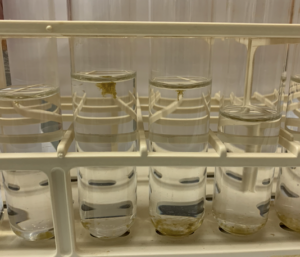Diatoms are types of algae widely distributed in global lakes and oceans. They often form blooms in the Great Lakes in the mid-east of North America, which contains 20% of Earth’s fresh water. Diatoms form beautiful glass structures as their cell walls and are rapidly evolving organisms that thrive in tropical and polar ecosystems. For this year’s Earth Day, Brittany Zepernick explains the importance of diatoms for global biogeochemistry and ecology and discusses how climate change might affect them. #MicrobiologyEvents
Some diatoms like it cold
For decades, researchers thought the winter waters of Lake Erie were “dead” and devoid of algal growth. Yet, ten years ago a winter survey of Lake Erie contested this theory with a shocking discovery: massive “blooms” of diatoms embedded within and underneath the ice (Figure 1).
The diatoms that formed these blooms have adapted to cold temperatures (are psychrophilic) and have cell walls made of silica. Further studies suggested that bacteria form tiny ice fragments on the diatom’s cell walls, allowing the algae to float to the water surface. Here, they embed in the ice cover, where there is adequate light to perform photosynthesis, which is why they play pivotal roles in lake biogeochemistry and ecology.
Interestingly, these winter diatoms rely on ice formation for survival as it allows them to optimize their location in the water column. Yet, climate change is jeopardizing this psychrophilic lifestyle and thus the viability of cold-adapted diatoms.

Climate change is decreasing ice formation in Lake Erie
Lake Erie is experiencing an unprecedented decrease in ice cover during the winter. Historically, an average of 80% of Lake Erie was covered with ice during the winter months. In contrast, only 5% of the lake was covered as of March 7th, 2023.
Ice-free conditions seem to promote wind-driven mixing of the lake, resulting in a muddy and light-limiting water column which is not favourable for diatom photosynthesis. How do diatoms respond to these increasingly ice-free conditions?
We chose to investigate this question by performing a 2-year Lake Erie survey during years of high (2019) and low ice (2020) formation. For our study, we extracted messenger ribonucleic acid (mRNA) from water samples to tell us how diatoms are responding to their environment at the exact moment they are collected.
The rafting hypothesis of psychrophilic diatoms
Our results indicated that some diatoms in the samples were increasing the expression of fasciclin genes during ice-free conditions. While fasciclins are largely unstudied in diatoms, prior research showed that these proteins are involved in cell adhesion and aggregation, allowing diatoms to form large visible colonies (Figure 2).
Furthermore, we observed that diatoms were increasing the expression of photosynthetic genes and proton-pumping rhodopsins. Notably, rhodopsins were recently found to allow for an alternative form of phototrophy in photosynthetic freshwater bacteria. These results suggested that diatoms may be light-limited in ice-free water and thus struggle to perform photosynthesis.
This led us to hypothesize that diatoms express fasciclins in muddy, ice-free conditions to “raft” to the lake surface where they can capture more light. Even in the absence of lake ice, they would have the ability to float to the surface where they could thrive and perform photosynthesis.

Psychrophilic diatoms adapting to climate change
Our findings suggest that cold-adapted diatoms in Lake Erie have a few tricks up their sleeve that would allow them to continue to thrive in today’s ice-free water columns. Even in a “climatically altered tomorrow”, these critical algae will continue to contribute to the lake’s biogeochemical and ecological processes.
Interestingly, our fasciclin-rafting hypothesis may not be limited to the winter Lake Erie water column. We discovered fasciclin proteins within ~140 freshwater and marine diatom taxa including the model polar marine diatom Fragilariopsis cylindrus within the icy Southern Ocean. As the Southern Ocean is largely dominated by diatoms, it accounts for ~50% of oceanic carbon dioxide uptake and plays a critical role in regulating the global carbon cycle. This critical ocean, much like Lake Erie, is suffering from climatic changes. Hence, both cold-adapted marine and cold-adapted freshwater diatoms seem to rely on a similar mechanism to survive within increasingly ice-free water columns: fasciclins.
- Discover more microbe days on #FEMSmicroBlog: Celebrating microbes every day
- Read also: #FEMSmicroBlog: Come spring they grill again – even in the Arctic Sea ice

Brittany Zepernick obtained her BS in Biology with a specialization in Marine and Aquatic Science and recently defended her PhD in Dr. Steven Wilhelm’s lab on Harmful Algal Blooms (HABs), which threaten global water quality. Her dissertation employed biomolecular tools to broadly focus on harmful algae in large lakes and climate change. Specifically, she investigated how pH (i.e., lake basification events) and ice cover constrain algal bloom success and succession within Lake Erie (US and Canada). In addition to her research, she seeks to improve regional water quality in Tennessee via various volunteer opportunities including river clean-ups and trail adoptions with the Tennessee Valley Authority (TVA) and a leadership role in the graduate student-led citizen science initiative “Knoxville Tennessee Environmental Soil and Stream Testing” (K-TESST).
About this blog section
The section #MicrobiologyEvents for the #FEMSmicroBlog reports about events and meetings relevant to our network. These include world awareness days, FEMS-sponsored meetings or meetings of Member Societies and many more.
| Do you want to be a guest contributor? |
| The #FEMSmicroBlog welcomes external bloggers, writers and SciComm enthusiasts. Get in touch if you want to share your idea for a blog entry with us! |
